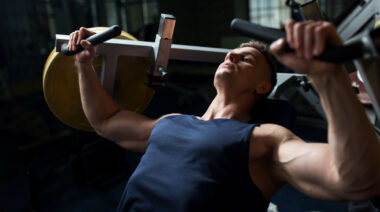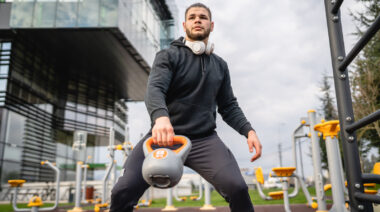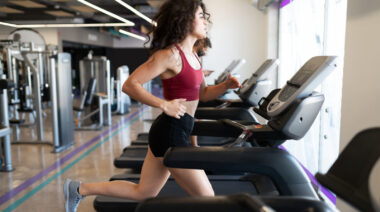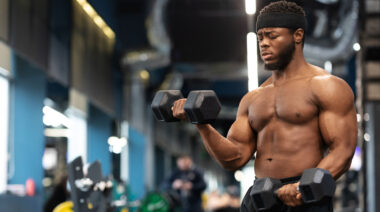“Wait, the bottoms-up press is more than just a nifty trick?”
That’s right! Most athletes have attempted a bottoms-up press, but typically only for fun, novelty, or perhaps for a bet. I know almost zero athletes (outside of core kettlebell enthusiasts) who actually incorporate the bottoms-up press into their program.
What makes the bottoms-up press so special? It requires habits, engagement, and a movement pattern that conspire to offer a completely unique training stimulus. The obvious difference is that the kettlebell is upside down with the bottom facing up. While this seems a bit silly at first, it creates a completely new set of demands.
Forcing a Full Grip
Bottoms-up presses (BUP) require a fully engaged grip for optimal performance. Even with a relatively minimal weight, pressing bottoms-up requires you to bear down hard on the handle to prevent the kettlebell from falling. BUPs also force you to engage your full hand and all five fingers. It is easy to fall into the bad habit of pressing with only the thumb and first finger or two engaged during standard kettlebell, dumbbell, and barbell presses. While a full grip during these movements will lead to heavier lifts and a greater training effect, they can still be performed with a relatively relaxed grip. Pressing bottoms-up forces the good habit of a full grip.
This full grip also turns on full engagement of your whole arm. Your pinky and ring finger act like neurological triggers for the outside of the forearm, the tricep, and the posterior part of your shoulder girdle. A strong grip with all five fingers ensures we use the whole arm and shoulder. For more on this grip phenomenon, check out my recent article on Turkish Get Ups.
Balance the Bell for Stability
An upside-down kettlebell poses an inherently unstable position. Simply holding a kettlebell bottoms-up presents a challenge. Pressing from this position requires the use of all of your smaller joint stability muscles that might not come to party during more stable pressing variations. We can get through most of the other pressing variations using mainly our largest, primary muscles. BUPs will shine a light on any imbalances or stability deficiencies and improve upon them all at once.
Building strength and power without addressing stability or balance is like putting a larger engine in an old car with bald tires, worn brakes, and questionable suspension. More power will improve the performance, but the greatest benefit comes from addressing the overall operation. The BUP is a more holistic overhead pressing movement because it brings all movers, macro and micro, to the party, and does not allow for any underdeveloped areas along the movement path.
A Different Movement Path
Apart from flipping the kettlebell on end, the most apparent difference when pressing bottoms-up comes in the path of travel. With all other pressing variations (single-arm and barbell), the goal remains to move the weight in the most efficient manner into lockout: a straight line.
The goal when pressing bottoms-up is maximal balance and stability. This comes from a vertical forearm with the elbow directly beneath the wrist. This path takes the kettlebell further from the body, increasing the lever arm between the shoulder and the line of travel, which increases the load and stability requirements.
Go Bottoms-Up to Kill Bad Habits
All of the above factors conspire together to make the bottoms-up press the perfect diagnostic test to find any deficiencies in your press. The BUP will not allow for many of the ways that athletes can mask weaknesses in their press. For example, the balance and stability requirements eliminate the possibility to use speed through phases of the movement that are typically less stable.
Many athletes will lean back during any other pressing variation to make it a more anterior (chest and frontal shoulder) movement, similar closer to a push up or bench press. While these movements have their place, overhead pressing should deliver a different training stimulus. Most modern humans are already well-acquainted with the front half of their upper body. The rolled-forward posture we use to sit, write, type, and drive combine with the priorities we bring to our training (heavy bench pressers, I’m looking at you) to create overly-developed chests and anterior shoulders, and heavily neglected posterior shoulders. The BUP ensures full posterior shoulder girdle engagement while preventing the possibility of reverting to already overly developed patterns.
Close the Engagement Gap
Think of the gap between your press and BUP weights as directly proportional to the stability and engagement deficiencies you have. The BUP not only shows these weaknesses, but is the best tool to resolve them. Switch to the BUP as your primary overhead press in training to increase your joint stability and develop the ability to engage all parts of your arm and shoulder.
Pressing bottoms-up will increase all of your other pressing movements. Improved joint stability tells your central nervous system that previously unstable positions are now safe. This allows full access to your strength in these ranges, increasing your press. Developing the neural connections that allow for more holistic engagement of your arm and shoulder acts as a catalyst for the strength gains that follow.
How to Use the Bottoms-up Press in Your Training
- Focus on stability, control, and full-body engagement. Bear down on your grip, squeeze your core, leg, and butt. Move slowly and maintain stability.
- Use lighter weight for more repetitions. The BUP will fatigue your less-used, smaller stabilizing muscles. You do not need a heavy weight to effectively train these. Use a weight as light as 50% of your press max for high-repetition sets. Train these until you start missing due to balance and stability. The weight will likely still feel light at this point, but you will lose the ability to keep the kettlebell steady through the full range of motion. Test heavier weights periodically to measure progress.
- Play with accessory movements in the bottoms-up position. Bottoms-up cleans, front squats, and carries are great options. Any overhead movement such as lunges, Turkish get ups, and windmills can also be done bottoms-up.
Focus on these key points to hone in your bottoms-up press:
- Wrist position – Set up with the line of your forearm leading straight through the center of the handle. Putting weight into this position (like you are doing a push up or plank on the kettlebell) will help find the strongest setup.
- Full grip – Squeeze firmly with all five fingers. This will not only help your balance but to engage your whole arm and shoulder.
- Vertical forearm – Keep your forearm vertical, with elbow directly beneath the kettlebell while pressing.
- Kettlebell path – As long as you focus on stability and a vertical forearm, the kettlebell can drift away from your body through the press. Many people find the most stability by pressing to their side rather than in front. Either works well as long as you do not lean too far back away from the kettlebell.
- Balance – Move slowly and keep your eye on the weight the entire time. Control the descent by actively pulling the kettlebell down to return.
- Solid base – As with every overhead movement, press with a tight core, legs, and butt.
Get warm before you go heavy:
The 3-Phase Kettlebell Warm Up






